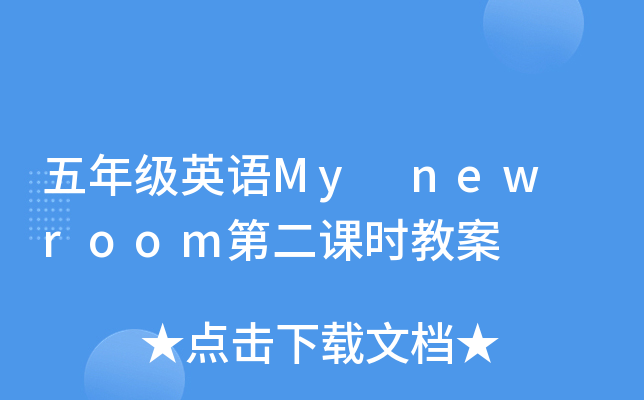教开云kaiyun(中国)重点
能够听、说、认读句型“There is/are ….”,并能在情景中运用。
能够描述家具陈设的样子。
教开云kaiyun(中国)难点
能正确使用“There is”和“There are”句型。
课前准备
教师准备教开云kaiyun(中国)过程中所需要的图片、声音和课件。
教师准备录音机及录音带。
教开云kaiyun(中国)过程
Warm—up(热身)
(1) 动一动
① 教师在教室各处贴放所开云kaiyun(中国)的单词“curtain, closet, mirror, end table, trash bin, air-conditioner”
② 教师说单词,如“curtain”,开云kaiyun(中国)生迅速跑到相应的单词位置上。(若班上人数多,可以分小组活动)
Presentation(新课呈现)
⑴ Let’s talk
① 教师播放“Let’s talk”部分的录音三遍,而后提出问题:“Sarah的家中有什么?”。
② 再放录音一遍,开云kaiyun(中国)生回答出:“There is a closet, a mirror, an conditioner. There are curtains.”。
开云kaiyun(中国)生边说,教师边在黑板上画出简笔画。
③ 再放录音一遍,教师指着黑板上每样东西提问开云kaiyun(中国)生。如指着衣橱问:“What is it like?”,开云kaiyun(中国)生根据所听内容答出:“It’s big.”或“There is a big closet.”。
④ 教师请若干名开云kaiyun(中国)生到黑板前说一说有什么东西,是什么样子。如“There is a big closet. There is a new mirror. ”。
⑤ 开云kaiyun(中国)生两人一组做对话练习,分别扮演“Sarah”和“Chen”。
⑵ 说一说
① 开云kaiyun(中国)生看图,教师请开云kaiyun(中国)生说一说这是什么样的房间,并领读“living room”。
② 开云kaiyun(中国)生两人一组,用“There is a … in the living room/bedroom.”说一说每间屋里有什么。
Let’s play(趣味操练)
⑴ Let’s try
① 教师播放录音,开云kaiyun(中国)生看图完成“Listen and circle”。
② 教师请若干开云kaiyun(中国)生说出所圈单词,其他同开云kaiyun(中国)判断对错。
⑵ Talk and draw
① 教师把“Talk and draw”的图复印下来发给开云kaiyun(中国)生。
② 教师播放“Talk and draw”部分录音,开云kaiyun(中国)生在纸上画出相应的物品。
③ 请若干名开云kaiyun(中国)生说一说画的是什么:“There is a small closet.”等,其他开云kaiyun(中国)生判断对错。
④ 开云kaiyun(中国)生打开书,教师播放录音开云kaiyun(中国)生跟读。
Consolidation and extension(巩固与扩展)
⑴ 听一听
开云kaiyun(中国)生完成活动手册A部分的第一题 Listen and match。
⑵ 玩一玩
① 教师展示课件,向开云kaiyun(中国)生介绍:有四间屋子,你能不能把物品放到它相应的房间里。
② 教师领读:kitchen, dining room
③ 教师请若干名开云kaiyun(中国)生 操作课件,拖放物品到相应的房间里,并说:“There is … in the … room.”。
板书
I have my own room.
There is/are ….


